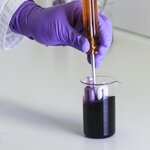Environment

Cool roofs, green roofs and hybrids of the two are all of the rage for city planners who want to do something about greenhouse-gas induced warming.
They sound great but is it going to work, or is it another idealized wish that incurs cost but has little benefit (like replacing spoons in the Congressional cafeteria with corn-based alternatives that melted in soup and ending up being worse for the environment) outside public relations campaigns? A team led by Matei Georgescu, an Arizona State University assistant professor in the School of Geographical Sciences and Urban Planning, decided…

50,000 years ago, the Arctic tundra was not as drab as you might think, being an Ice Age - it was filled with colorful wildflowers and these wildflowers helped sustain woolly mammoths and other giant grazing animals, according to a new paper. The study challenges the view that the arctic landscape in the ice age was largely grasslands.
The study looked at 50,000 years of arctic vegetation history to understand how fauna had changed with animals and humans. Historically, the belief has been that the ice age's landscape was covered by largely grass-dominated systems -- called steppe…

For the past eight years, the Amazon rain forest has gotten greener as the weather seemingly got hotter and drier each year from June to October.
Limited rainfall didn't prevent thriving vegetation, which really put a damper on the simplistic 'turn one climate knob and all of our issues are solved' narrative.
Finally, researchers have an answer. It's a trick of light, a combination of shadowing within the canopy and the way that satellite sensors observe the Amazon during the dry season and not a biophysical change in Amazon forests that defied eco-logic.
The MODIS, or…

The increasing use of chemical herbicides, both synthetic and organic kinds, is often blamed for the declining plant biodiversity in farms, but it is simplistic to think herbicide exposure is solely to blame.
The science doesn't add up. If herbicides are a key factor in declining diversity, then thriving species would be more tolerant to widely used herbicides than rare or declining species, according to J. Franklin Egan, research ecologist, USDA-Agricultural Research Service. But that isn't the case.
"Many ecotoxicology studies have tested the response of various wild plant species to low…

Compact fluorescent bulbs save energy but they also contain mercury, a toxic metal.
While environmentalists have promoted them as safe, and the US government has given them a de factor mandate and subsidy by banning incandescent bulbs, there are still concerns among the public about the risks of having hazardous materials in their homes.
Mercury lamps, on the other hand, have been around since 1860. They were rarely used in the home, they are a big part of the reason why incandescent bulbs were invented in the first place, because they made human skin look 'green' and the risks in an enclosed…

Though you may have read otherwise, numerous studies from China, Spain and the United States have have found that the biodiversity of insects and related arthropods is not reduced by genetically modified (GM) rice, cotton, or maize fields.
A new study from South Africa published in Environmental Entomology shows similar results, that biodiversity is the same as that among conventional crops.
A total of 8,771 arthropod individuals, comprising 288 morphospecies, were collected from 480 plants sampled from Bt maize and non-Bt maize fields over a two-year period. The researchers found no…

Under-use of fertilizers in Africa currently contributes to a growing yield gap; the difference between how much crops could produce in ideal circumstances compared to actual yields.
Better yields mean more food and sustainable food leads to wealth and culture and a better life.
But fertilizer has to be smartly applied, with both phosphorous and nitrogen, and the difference between them is substantial for subsistence farmers. While nitrogen-based fertilizers can be produced by a process that extracts the element from the air, phosphorus must be mined from rock—and reserves are…
I was checking out my trusty Cotton Physiology Handbook and have to admit that I got a bit blown away..
What is a xylem?
Plants have vascular systems just like people, but for plants, rather than moving blood through arteries and veins, plants (like my beloved cotton) move water, nutrients and energy. The xylem is the part of the system that pulls water and nutrients up. So with that, let me step back a little bit.
Understanding Plant Vascular Systems
A leaf’s vascular system diagram from Dr. Mike Farabee, Estrella Mountain Community College
The primary components of the…
I was checking out my trusty Cotton Physiology Handbook and have to admit that I got a bit blown away..
What is a xylem?
Plants have vascular systems just like people, but for plants, rather than moving blood through arteries and veins, plants (like my beloved cotton) move water, nutrients and energy. The xylem is the part of the system that pulls water and nutrients up. So with that, let me step back a little bit.
Understanding Plant Vascular Systems
A leaf’s vascular system diagram from Dr. Mike Farabee, Estrella Mountain Community College
The primary components of the…

Government can really only do one thing; tax and penalize. The other actions it takes, even positive ones like the police and fire departments and protecting the environment, derive from one of those two.
But when it comes to conservation, activists may be taking the wrong approach. While they pay lobbyists to get more laws and enforcement, when it comes to poaching, it just attracts organized criminals who have the capacity to operate even under increased enforcement effort. Funding is at record levels for enforcement and it isn't doing much good.
The smarter approach would…